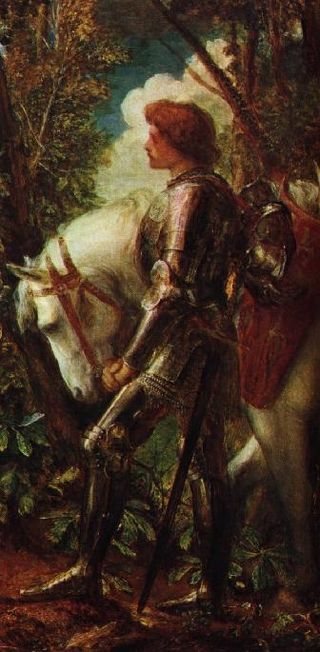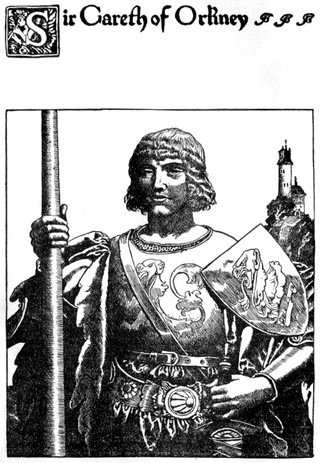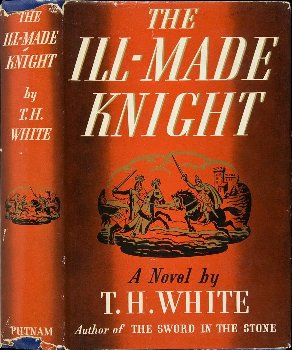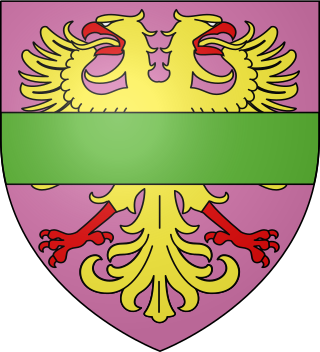
Guinevere, also often written in Modern English as Guenevere or Guenever, was, according to Arthurian legend, an early-medieval queen of Great Britain and the wife of King Arthur. First mentioned in literature in the early 12th century, nearly 700 years after the purported times of Arthur, Guinevere has since been portrayed as everything from a fatally flawed, villainous, and opportunistic traitor to a noble and virtuous lady. The variably told motif of abduction of Guinevere, or of her being rescued from some other peril, features recurrently and prominently in many versions of the legend.

Idylls of the King, published between 1859 and 1885, is a cycle of twelve narrative poems by the English poet Alfred, Lord Tennyson which retells the legend of King Arthur, his knights, his love for Guinevere and her tragic betrayal of him, and the rise and fall of Arthur's kingdom.

Lancelot du Lac, alternatively written as Launcelot and other variants, is a popular character in Arthurian legend's chivalric romance tradition. He is typically depicted as King Arthur's close companion and one of the greatest Knights of the Round Table, as well as a secret lover of Arthur's wife, Guinevere.

Mordred or Modred is a major figure in the legend of King Arthur. The earliest known mention of a possibly historical Medraut is in the Welsh chronicle Annales Cambriae, wherein he and Arthur are ambiguously associated with the Battle of Camlann in a brief entry for the year 537. Medraut's figure seemed to have been regarded positively in the early Welsh tradition and may have been related to that of Arthur's son. As Modredus, Mordred was depicted as Arthur's traitorous nephew and a legitimate son of King Lot in the pseudo-historical work Historia Regum Britanniae, which then served as the basis for the following evolution of the legend from the 12th century. Later variants most often characterised Mordred as Arthur's villainous bastard son, born of an incestuous relationship with his half-sister, the queen of Lothian or Orkney named either Anna, Orcades, or Morgause. The accounts presented in the Historia and most other versions include Mordred's death at Camlann, typically in a final duel, during which he manages to mortally wound his own slayer, Arthur. Mordred is usually a brother or half-brother to Gawain; however, his other family relations, as well as his relationships with Arthur's wife Guinevere, vary greatly.

Galahad, sometimes referred to as Galeas or Galath, among other versions of his name, is a knight of King Arthur's Round Table and one of the three achievers of the Holy Grail in Arthurian legend. He is the illegitimate son of Sir Lancelot du Lac and Lady Elaine of Corbenic and is renowned for his gallantry and purity as the most perfect of all knights. Emerging quite late in the medieval Arthurian tradition, Sir Galahad first appears in the Lancelot–Grail cycle, and his story is taken up in later works, such as the Post-Vulgate Cycle, and Sir Thomas Malory's Le Morte d'Arthur. In Arthurian literature, he replaced Percival as the hero in the quest for the Holy Grail.

The Knights of the Round Table are the legendary knights of the fellowship of King Arthur that first appeared in the Matter of Britain literature in the mid-12th century. The Knights are a chivalric order dedicated to ensuring the peace of Arthur's kingdom following an early warring period, entrusted in later years to undergo a mystical quest for the Holy Grail. The Round Table at which they meet is a symbol of the equality of its members, who range from sovereign royals to minor nobles.

Gareth is a Knight of the Round Table in Arthurian legend. He is the youngest son of King Lot and Queen Morgause, King Arthur's half-sister, thus making him Arthur's nephew, as well as brother to Gawain, Agravain and Gaheris, and either a brother or half-brother of Mordred. Gareth is particularly notable in Le Morte d'Arthur, where one of its eight books is named after and largely dedicated to him, and in which he is also known by his nickname Beaumains.

Bors is the name of two knights in Arthurian legend, an elder and a younger. The two first appear in the 13th-century Lancelot-Grail romance prose cycle. Bors the Elder is the King of Gaunnes (Gannes/Gaunes/Ganis) during the early period of King Arthur's reign, and is the brother of King Ban of Benoic and the father of Bors the Younger and Lionel. His son Bors the Younger later becomes one of the best Knights of the Round Table and participates in the achievement of the Holy Grail.

The Ill-Made Knight is a fantasy novel by British writer T. H. White, the third book in the series The Once and Future King. It was first published in 1940, but is usually found today only in collected editions of all four books of the novel.
Maleagant is a villain from Arthurian legend. In a number of versions of a popular episode, Maleagant abducts King Arthur’s wife, Queen Guinevere, necessitating her rescue by Arthur and his knights. The earliest surviving version of this episode names the abductor Melwas; as Maleagant, he debuts as Lancelot's archenemy in Chrétien de Troyes' French romance Lancelot, the Knight of the Cart. However, all surviving versions seem to be later adaptations of a stock narrative of significantly earlier provenance.

Merlin is a 1998 two-part television miniseries starring Sam Neill as Merlin, recounting the wizard's life in the mythic history of Britain. Loosely adapted from the legendary tales of Camelot, the plot adds the antagonistic Queen Mab and expands Merlin's backstory before the birth of King Arthur.

Agravain is a Knight of the Round Table in Arthurian legend, whose first known appearance is in the works of Chrétien de Troyes. He is the second eldest son of King Lot of Orkney with one of King Arthur's sisters known as Anna or Morgause, thus nephew of King Arthur, and brother to Sir Gawain, Gaheris, and Gareth, as well as half-brother to Mordred. Agravain secretly makes attempts on the life of his hated brother Gaheris starting in the Vulgate Cycle, participates in the slayings of Lamorak and Palamedes in the Post-Vulgate Cycle, and murders Dinadan in the Prose Tristan. In the French prose cycle tradition included in Thomas Malory's Le Morte d'Arthur, together with Mordred, he then plays a leading role by exposing his aunt Guinevere's affair with Lancelot, which leads to his death at Lancelot's hand.
King Claudas is a fictional king who is an opponent to King Arthur, Lancelot, and Bors in Arthurian literature. His kingdom is situated in the Berry and is named "Terre Deserte", or "Land Laid Waste", so called because of the destruction Uther Pendragon had wrought there.

The Candle in the Wind is a fantasy novel by English writer T. H. White, the fourth book in the series The Once and Future King. Written in 1940, it was first published in 1958 in the collected edition. It deals with the last weeks of Arthur's reign, his dealings with his son Mordred's revolts, Guinevere and Lancelot's demise, and his perception of right and wrong.

Adventures of Sir Galahad is the 41st serial released in 1949 by Columbia Pictures. Directed by Spencer Gordon Bennet, it stars George Reeves, Nelson Leigh, William Fawcett, Hugh Prosser, and Lois Hall. It was based on Arthurian legend, one of the very few serials of the time with a period setting that was not a western.

Queen of Camelot is an Arthurian-legend based novel shown through the viewpoint of Queen Guinevere. It is a combination of two of Nancy McKenzie's previous books The Child Queen and The High Queen. She states in the foreword that she originally intended the novels to be combined, but they were split at the time of publication because of their length.
"The Bramble Briar", "The Merchant's Daughter" or "In Bruton Town" is a traditional English folk murder ballad that tells the story of how two brothers murder a servant who is courting their sister. There are many versions of the song going by a number of different titles.

Unholy Grail is a horror comic book series written by Cullen Bunn and illustrated by Mirko Colak, published by American company AfterShock Comics. The colorist is Maria Santaolalla, and the letterer is Simon Bowland.

King Arthur(Arthur Pendragon) is a legendary figure used commonly in comic books.


















